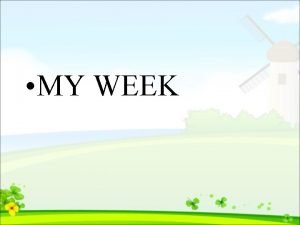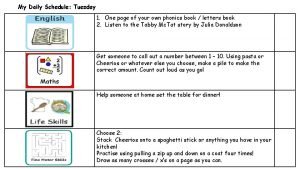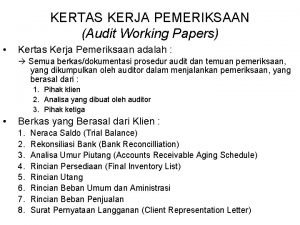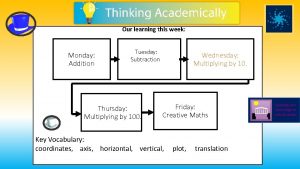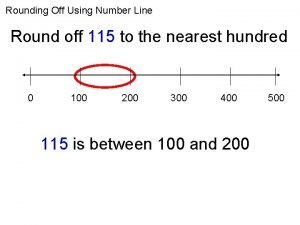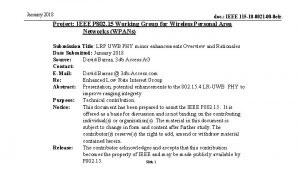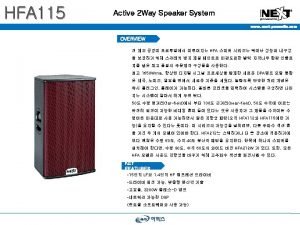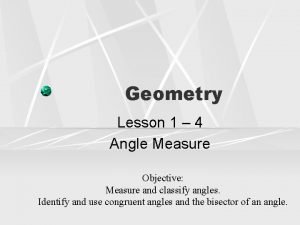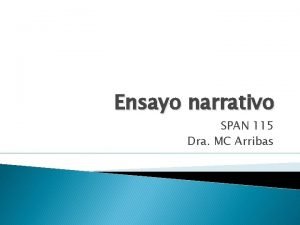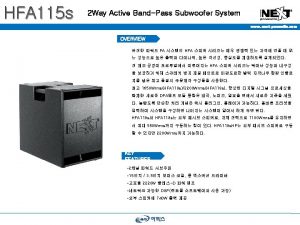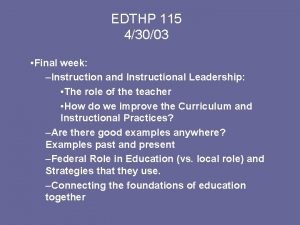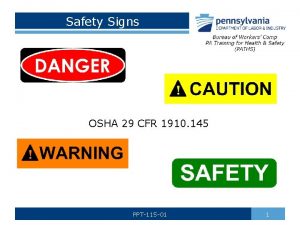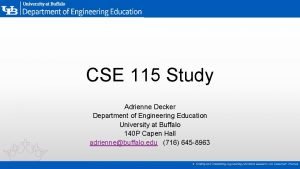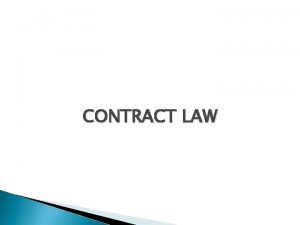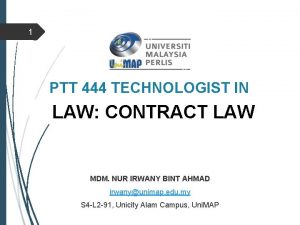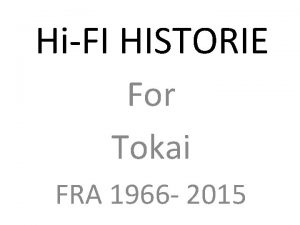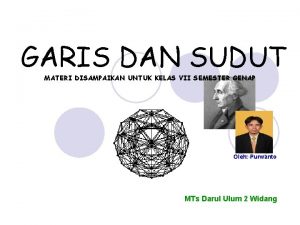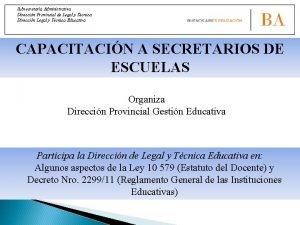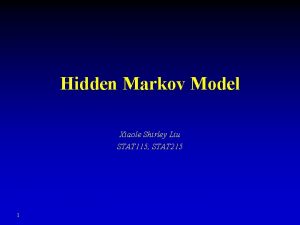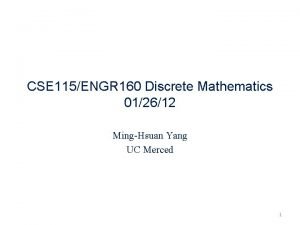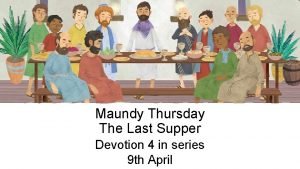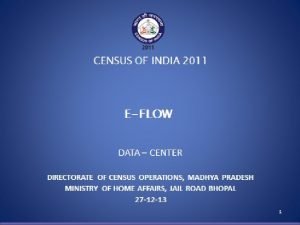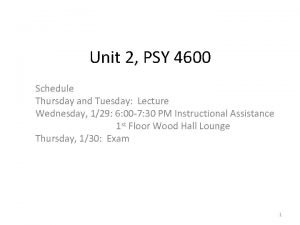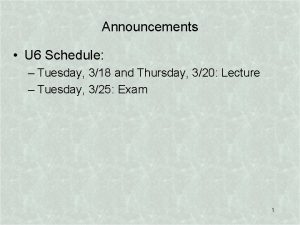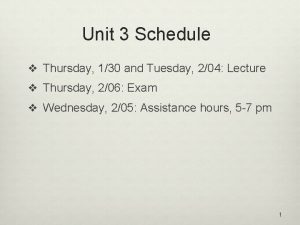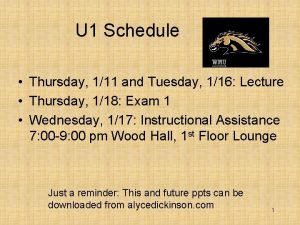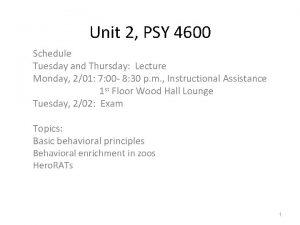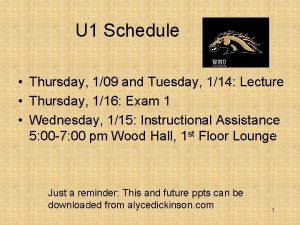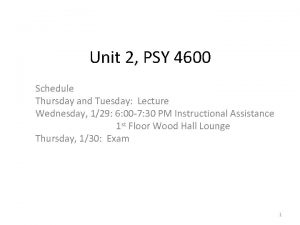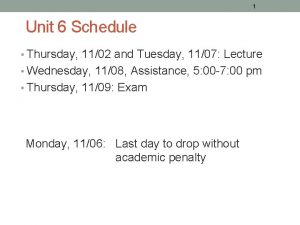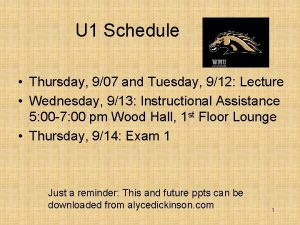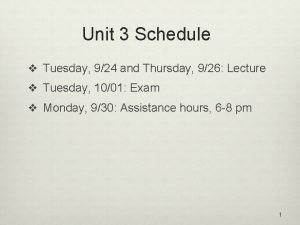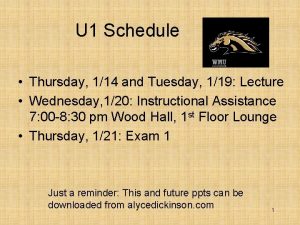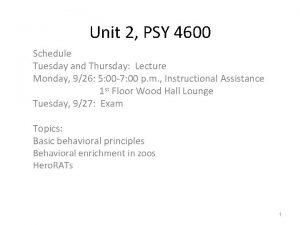U 1 Schedule Thursday 110 and Tuesday 115
















































- Slides: 48

U 1 Schedule • Thursday, 1/10 and Tuesday, 1/15: Lecture • Thursday, 1/17: Exam 1 • Wednesday, 1/16: Instructional Assistance 7: 00 -9: 00 pm Wood Hall, 1 st Floor Lounge Just a reminder: This and future ppts can be downloaded from alycedickinson. com 1

Unit 1 Overview • Main emphasis: Respondent behavioral relations and respondent conditioning – Many think respondent conditioning is not very important in everyday human affairs, but Chance argues that point – Respondent conditioning = Pavlovian conditioning = classical conditioning • Review of basic concepts (Malott, Pietras) Start with basic definitions, abbreviations, diagramming conventions 2

Respondent and Operant Relations Respondent S ---> R 1. US ---> UR 2. CS ---> CR Operant R--->Sc SD or S∆: R--->Sc MO: SD or S∆: R--->Sc SO 2: Diagramming Conventions A. B. C. D. Respondent: Operant with SD: Operant with S∆: S ----> R R ----> Sc SD: R ----> Sc (SR/Sr) S∆: R ----> Sc (Ext) Note: NOT SD ---> R ---> Sc, but SD: R --->Sc (Malott, box diagrams, arrow denotes temporal relations, but conventionally, contingent relation, If-then) 3

SO 3: Stimulus/Stimuli • Definition (note bold face in SOs!) – An energy change that affects the organism through its receptors • Examples of stimuli – Respondent: USs and CSs – Operant: SDs, S∆s, all consequences • Some stimuli for humans (not for the exam; see study objectives for additional examples) – Visual: • Energy change: electromagnetic wavelengths, photons • Receptor: photoreceptors in eyes – Auditory: • Energy change: vibration of molecules • Receptor: phonoreceptors in ears (hear, taste, touch, see, feel: examples - physical energy change/receptors) 4

SO 4 A. When analyzing the behavior of a particular individual, environmental events are always classified from the perspective of the behaver. (often mix up stimuli and responses: 2 important points about stimuli) 5

Stimulus vs. Behavior In the following examples of operant relations, should we classify the consequence for the R as a behavior or a stimulus? A. R (drink hot liquid)-->Pain (burn tongue) B. R (answers lecture question correctly)--> Praise C. R (answers lecture question correctly)-->OK gesture D. R (rat presses lever)-->Light comes on E. R (baby coos)-->Parent strokes baby’s arm 6

SO 4 B An energy change cannot be a stimulus for an organism if: 1. The organism does not have a receptor that can detect it (across species differences) 2. The organism’s receptor is damaged and thus cannot detect it (within species differences) (important to stress energy change that affects the receptors, cont, look at examples) 7

SO 4 B An energy change cannot be a stimulus for an organism if: 1. The organism does not have a receptor that can detect it (across species differences) A. Dog whistles Phonoreceptors of dogs can detect faster vibrations of molecules than can the phonoreceptors of humans. Faster vibrations (high tones), are energy changes, and can be stimuli for dogs but not for humans because humans do not have receptors that can detect them. B. X-rays are energy changes, but they cannot be stimuli for humans because humans do not have receptors that can detect them. (bats, sharks, echolocate, etc. – radar/sonar -important to stress energy change that affects the receptors, cont) 8

SO 4 B An energy change cannot be a stimulus for an organism if: 2. The organism’s receptor is damaged and thus cannot detect it (within species differences) In this case, the energy change can be a stimulus for one person or organism of the same species, but not for the organism with the damaged receptor A. Damaged phonoreceptors Hunter’s phonoreceptors are damaged due to firing rifles close to his/her ear so high tones do not affect his/her receptors (problem for veterans as well) High tones, which are energy changes, can be stimuli for others, but not for this hunter. 9

SO 4 B – Another Example • The Mosquito: Box that emits a shrill piercing noise • Used to prevent loitering by teens • The sound is audible to teens and young adults, but typically not adults (older than mid 20 s) • Can be heard by animals and babies, but is only aversive to children older than 12 – “teen-repellent” • Teens say: “It’s horrible, loud, and irritating. It’s this screeching sound that you have to get away from or it will drive you crazy. ” • Why? Heard by teens and young adults who still have sensitive hair cells in their inner ears, hair cells that don’t develop until teen years – Energy change is the same but differences are due to the receptors (not yet developed, deterioration due to age) 10

SO 5: Behavior/Response (Dead man’s - person’s - rule) 1. Movement of the skeletal muscles (striped, striated) Muscles attached to bones and move bones when they contract: fingers, arms, legs, back, vocal app. 2. Movement of the smooth muscles Located in blood vessels - face flushes or blanches Around hair follicles - hair stands up on end In eye - pupils constrict or dilate Digestive, reproductive, respiratory system, cardiac muscle 3. Secretion of the glands Sweat glands, salivary glands, lachrimal glands, adrenal gland (also electrical conductivity/activity of skin, gsr, but not requiring this) 11

SO 6: Response vs. Response Product • Response Movement of the skeletal muscles, movement of the smooth muscles, and secretion of the glands • Response Product (response-produced stimuli) Stimuli that are produced or result from the response (often said that the behavior of someone serves as an SD or reinforcer for the behavior of another; That is not true; it’s the response product, the stimuli that result from the behavior that serves as the SD/reinforcer – as we just wen over in SO 4. I am hoping this distinction between r and rp will help you understand this better; cont. ) 12

SO 6: Response vs. Response product, cont. When a person makes a thumbs up gesture: • Response: movement of the skeletal muscles • Response product: visual stimulus of the thumbs up When a person claps his hands together: • Response: movement of the skeletal muscles • Response product: visual and auditory stimulus of the “clap” When a person cries: • Response: secretion of the gland (lachrymal) • Response product: visual stimulus of the “tears” (Technical answers: not making the thumbs up gesture, or seeing the thumbs up; Again, the take-home point here is that it is the response product – the response-produced stimuli that serve as SDs, reinforcers, punishers for the 13 behavior of others: not the response/behavior of the person)

SO 7: Types of Behaviors and Relationship to Type of Conditioning • Relationship to operant and respondent relations and conditioning (typically) –Movement of skeletal muscles: Operant – (a) Movement of the smooth muscles & (b) Secretion of the glands*: Respondent Commonality? Behaviors controlled by autonomic nervous system (*also GSR, but not requiring this: clearly exceptions - next slide) 14

SO 8 Exception US (pain to hand/foot) ---> UR (hand/foot withdrawal) Why is this an exception? The relation is a respondent relation, but the response is movement of the skeletal muscles (rather than movement of the smooth muscles or glandular secretion). It is incorrect to say that the hand/foot withdrawal is operant behavior? Why? 15

SO 9 Behavior vs. Behavioral Relations: What is the Difference? • Behavior – Movement of the skeletal muscles, movement of the smooth muscles, and glandular secretion • Behavioral Relations – Behavior plus causal stimuli, e. g. , Respondent: US UR CS CR Operant: (examples next) R SR or Sr SD: R SR or Sr MO: SD: R SR or Sr 16

SO 9 Behavior vs. Behavioral Relations: Examples • Respondent: – Behavior: salivation – Relation: US (food in mouth) UR (salivation) – Relation: CS (tone) CR (salivation) • Operant: – Behavior: Press power button on TV remote – Relation: R (press button) Sr (TV comes on) – Behavior: rat presses a lever – Relation: MO (food dep): SD (light on): R (press lever) SR (food) (not NS does not elicit a response) 17

SO 9 Behavior vs. Behavioral Relations: Why is the distinction important? * • A behavior, such as crying, can be caused by very different variables - it can also have multiple causes. (onions, operant crying, both - pain, Sr) – US (fumes from peeling onions) UR (crying) – R (woman crying) Sr (please don’t cry, I didn’t mean it) – US (pain) UR (crying) Sr (poor baby, hug) • Respondent relations: tendency to call a behavior rather than a relation inherited – US (food in mouth) UR (salivation) – CS (tone) CR (salivation) • In order to understand change behavior we must know what is causing it (*this slide, NFE) 18

SO 12 Unconditioned Respondent Relations Examples in study objectives; for the exam learn the ones numbered 1, 2, 3, 5, 6, 7, & 11 1. 2. 3. 4. 5. 6. 7. 8. 9. 10. 11. US (light increase) --> UR (pupil of eye constricts) US (light decrease) --> UR (pupil of eye dilates) US (touch to eye/chemical irritant) --> UR (lachrimal gland secretion) US (irritation to nasal mucosa) --> UR (sneezing) US (irritation to throat) --> UR (cough) US (low temperature) --> UR (shivering, surface vasoconstriction) US (high temperature) --> UR (sweating, surface vasodilation) US (cold/fright) --> UR (hair stands on end) US (food in mouth) --> UR (salivation) US (bad food in stomach) --> UR (vomiting) (NEXT SLIDE - EMOTIONS) (Skipping to SO 12: focus on respondent this unit. On exam, if US, give UR; if UR, give US, or whole relation) 19

SOs 12 &13: Emotions ALL emotions (joy, anger, sadness) consist of: A collection of respondent behaviors elicited by a stimulus that is (1) painful, (2) very intense, or (3) very unusual and together is called the activation syndrome. US Pain Very intense stimulus Very unusual/surprising UR: Activation Syndrome Heart rate increase Adrenaline secretion Release of sugar into blood stream Blood vessel constriction Galvanic skin response (pain is always a stimulus, never a response!; note respondent – do not leave this out 20 of the definition - it is a critical part - emotions are not operant behavior)

SO 14: Lower-order and Higher-order Respondent Conditioning Definition: Respondent Conditioning (not for the exam): A neutral stimulus is repeatedly paired with a US or CS that elicits a response, and the NS becomes a CS that elicits the same response. Qualifier: The response is the same in the sense that it involves the same muscle movement or glandular secretion but may differ in intensity. (Conditioning, making new CS->CR relations) 21

SO 14: Lower-order Respondent Conditioning Diagram Four parts to the diagram! NS does NOT elicit R (either as a UR or CR) US -----> UR NS/US -----> UR (NS and US paired several times) CS -----> CR Critical Features: • US always elicits a UR (never an “R” or “CR”) • NS always precedes US to ensure conditioning • Pairing is symbolized with / (Not an arrow) • NS becomes a CS when it elicits the response • CS always elicits a CR (never an “R” or “UR”) • CR must be the same response as the UR • CS must occasionally be paired with US (exam: not ask critical features) 22

SO 14 A: Pavlov’s Original Study Example of Lower-order Conditioning NS (tone) does not elicit R (salivation) US (meat powder in mouth) -----> UR (salivation) NS (tone) / US (meat powder in mouth) -----> UR (salivation) CS (tone) ----> CR (salivation) (Russian Physiologist) Review of Critical Features: • US always elicits a UR (never an “R” or “CR”) • NS always precedes US to ensure conditioning • Pairing is symbolized with / • NS becomes a CS when it elicits the response • CS always elicits a CR (never an “R” or “UR”) • CR must be the same response as the UR • CS must occasionally be paired with US 23

Skip to SO 15: Respondent Extinction NS (tone) does not elicit R (salivation) US (meat powder in mouth) ---> UR (salivation) NS/US (meat powder in mouth ---> UR (salivation) CS (tone) ---> CR (salivation) How would you respondently extinguish the CR (the salivation response) to the CS (the tone)? Repeatedly present the CS (the tone) without the US (meat powder in the mouth) Why is “present the CS” wrong? (without repeatedly) Skipping 14 C-E for now (Problem with “pair” instead of “present”; Extinguish vs. extinct, next slide) 24

Extinguish vs. extinct 25

SO 14 C: Higher-order Respondent Conditioning Lower-Order NS does not elicit R US ---> UR NS/US ---> UR CS ---> CR Higher-Order NS does not elicit R CS 1 ---> CR 1 NS/CS 1 ---> CR 1 CS 2 ---> CR 2 SO 14 D: Difference in Words In lower-order conditioning, the NS is repeatedly paired with a US while in higher-order conditioning the NS is repeatedly paired with a CS. 26

SO 14 C: Example of Higher-Order Respondent Conditioning Pavlov’s Lower-Order Conditioning Study NS (tone) does not elicit R (salivation) US (meat powder in mouth) ---> UR (salivation) NS/US (meat powder in mouth ---> UR (salivation) CS (tone) ---> CR (salivation) Higher-order Respondent Conditioning NS (bright orange light) does not elicit R (salivation) CS 1 (tone) ---> CR 1 (salivation) NS (bright orange light)/CS 1 (tone) ---> CR 1 (salivation) CS 2 (orange light) ---> CR 2 (salivation) (cool examples in text related to advertising; George Clooney, Jack Sparrow/Johnny Depp/Riker, 27 beer commercials; cars with models; on exam, CS 1 - second diagram)

SO 14 E: Watson & Raynor, Little Albert Respondent Conditioning of Emotions NS (white rat) does not elicit R (fear, startle) US (loud noise) ---> UR (fear, startle) NS (white rat) / US (loud noise) ---> UR (fear, startle) CS (white rat) ---> CR (fear, startle) REVIEW SO 15: Extinction of CR How would you extinguish the fear, startle response? (emotions vs. simple reflexes, all emotions were genetic, 11 th, diagram this study, question, not answer, process of extinction often forms the basis for treatment of most phobias; article 4 yrs ago – who 28 Was little Albert and what happened to him? American Psychologist)

SO 16 Assume, as actually happened, that Watson and Raynor did not extinguish the fear, startle response. Also, assume Little Albert has not had any contact with white rats for 1 year after he left Watson and Raynor. If you showed him a rat, would he exhibit a fear, startle response? 29

SO 17: Counterconditioning is NOT the same thing as extinction. Extinction: The CR is eliminated by repeatedly presenting the CS without pairing it again with the US or CS 1 Counterconditioning: Not only is the CR eliminated, but it is replaced with an incompatible response. The CS that elicits the CR is repeatedly paired with a stimulus that elicits an incompatible response. (Extinction is not the same as elimination, specific process, counterconditioning usually faster; also used to treat phobias) 30

SO 17: Peter’s Original Conditioning: Same as Little Albert’s Except a Rabbit NS (rabbit) does not elicit R (fear, startle) US (loud noise) ---> UR (fear, startle) NS (rabbit) / US (loud noise) ---> UR (fear, startle) CS (rabbit) ---> CR (fear, startle) (NFE, but important so that you understand the counterconditioning, same except rabbit) 31

SO 17: Counterconditioning Peter’s Fear, Startle Response NS (rabbit) does not elicit R (pleasant emotions, salivation) US (milk, crackers)---> UR (pleasant emotions, salivation) NS (rabbit) / US (milk, crackers)---> UR (pl. emtns, sal. ) CS (rabbit) ---> CR (pleasant emotions, salivation) Note the first line of the diagram. Important!! (SO 17 A, diagram; SO 17 B, conditioned rabbit to elicit unpleasant emotions; stress NS first line, extinction embedded) 32

SO 18: Pavlov’s Study Counterconditioning: Dogs and Masochists NS (shock) does not elicit R (salivation) US (meat powder in mouth) -----> UR (salivation) NS (shock) / US (meat powder in mouth) -----> UR (salivation) CS (shock) ----> CR (salivation) (dogs acted as if they “liked” the shock, shock did not elicit normal Rs after conditioning, Chance - not refer to this as counterconditioning, not always going to happen - factors? ? ) 33

SOs 19 -20: Staats & Staats • To date: Respondent conditioning can account for emotions to stimuli that are paired with a US, e. g. , Little Albert’s fear/startle response • Series of three studies showing how emotions to things/people/ethnic groups that we have never had contact with can be respondently conditioned Nonsense syllables Names of males (e. g. , Tom, Bill) Nationalities (e. g. , German, Dutch, Swedish) (higher order conditioning, increasing applied relevance and implications) 34

Staats & Staats Study • Participants were college students • Slides with names of nationalities shown on a screen • Words said to participants, which they repeated while slides were shown • Purpose? How visual learning affected auditory learning • Ps told they would be asked to recall as many of the words as possible. 35

Staats and Staats Study, cont. 1. Slides saying Dutch were paired with words that elicited pleasant emotional reactions NS (Dutch)/CS 1 (joy, happiness) CR 1 (plsnt emotions) 2. Slides saying Swedish were paired with words that elicited negative emotional reactions NS (Swedish)/CS 1 (death, pain) CR 1 (unplsnt emotions 3. (Control) Slides saying German, Italian, French were paired with words that did not elicit emotional reactions NS (German)/NS (book, table) No emotional reaction NS = nationalities (German, Dutch, Swedish) CS 1 = words that elicited emotional reactions (joy, happiness) NS = words that did not elicit emotional reactions (book, table) (SO 19: full diagrams later) 36

Staats & Staats Dependent Variable College students rated the extent to which the nationalities were pleasant or unpleasant on a 7 -point rating scale. They rated: • Dutch as very positive/pleasant • Swedish as very negative/unpleasant • German, Italian, and French as neutral. When asked why they rated them that way, the students could not tell the experimenters. That is, the conditioning occurred completely without their awareness. 37

SO 19: Diagrams for Staats and Staats NS (Dutch) does not elicit R (pleasant emotions) CS 1 (joy, gift) ---> CR 1 (pleasant emotions) NS (Dutch)/CS 1 (joy, gift) ---> CR 1 (pleasant emotions) CS 2 (Dutch) ---> CR 2 (pleasant emotions) NS (Swedish) does not elicit R (neg. emotions) CS 1 (death, pain) ---> CR 1 (neg. emotions) NS (Swedish)/CS 1 (death, pain) ---> CR 1 (neg. emotions) CS 2 (Swedish) ---> CR 2 (neg. emotions) NS (German) does not elicit R (any emotions) NS (table, chair) ---> No R (no emotions) NS (German)/NS (table, chair) ---> No R (no emotions) NS (German) ---> No R (no emotions) (note: last is not really respondent conding; must begin with nationalities that are NS, not Dutch here) 38

SO 20: Staats & Staats Wrap-up • The DV consisted of the extent to which students rated the nationalities as pleasant/unpleasant on a 7 point rating scale. Was this the CR? Why or why not? • Chance called the words “neutral words, ” “positive words, ” and “negative words. ” This is NOT good behavioral terminology. What is wrong with this way of describing the words? (not in study objectives, but fair game for the exam) (Stimulus vs. response) 39

Staats & Staats Implications If you grow up in a social environment where international or minority groups are always described in negative terms, you are going to develop negative emotional reactions to those groups, even if you have not had any contact with them. If Italians are always paired with “gangsters, ” or “mafia, ” if females are described as “inferior, ” if Jews are described as “sly” and “shrewd, ” if Arabs and Muslims are always described as “terrorists, ” if gays are always described as “immoral, ” etc. , you can develop negative reactions to those groups. (Jersey Shore Family Vacation) 40

The End But don’t forget to study the SOs that I did not cover in lecture – you are responsible for all of them (except the ones that explicitly indicate NFE – not for exam) • Instructional Assistance Hours: Wednesday, 1/16, 7: 00 -9: 00 pm Wood Hall Lounge, First Floor Sage is in charge! • Email addresses for TAs are in the syllabus • ppt is posted on my web page: alycedickinson. com Slides on elicit, evoke, and emit follow this slide, slides 42 -48 41

SO 21 Elicit, Evoke, and Emit • Elicit: USs elicit URs and CSs elicit CRs – Elicit is only used in respondent relations • Correct: Food, the US, elicited salivation • Incorrect: The light, an SD, elicited a lever press – Only USs and CSs elicit responses: Note carefully that organisms do not elicit responses! • Correct: Food, the US, elicited salivation • Incorrect: Pavlov’s dogs elicited salivation – Only responses can be elicited • Correct: Food, the US, elicited salivation • Incorrect: Food, the US, elicited the tone, the CS 42

SO 21 Examples: Is elicit used correctly? Why or Why not? • When the temperature is cold, a person elicits a shivering response. • The SD (a tone) elicited the behavior of turning in a circle by the pigeon. • The CS (a tone) elicited the CR (salivation). • Pressing the lever elicited the reinforcer of food. • In lower order conditioning, the NS elicits the US. See slide 48 for answers 43

SO 21 Elicit, Evoke, and Emit • Evoke: USs, CSs, and SDs evoke responses – Evoke is used in both respondent and operant relations • Correct: Food, the US, evoked salivation • Correct: The light, an SD, evoked a lever press – Only USs, CSs, and SDs evoke responses: Note carefully that organisms do not evoke responses! • Correct: The light, an SD, evoked a lever press • Incorrect: The rat evoked a lever press – Only responses can be evoked • Correct: The light, an SD, evoked a lever press • Incorrect: The lever press evoked reinforcement – Incorrect for two reasons! 44

SO 21 Examples: Is evoke used correctly? Why or why not? • When the temperature is cold, a person evokes a shivering response. • The SD (a tone) evoked the behavior of turning in a circle by the pigeon. • The CS (a tone) evoked the CR (salivation). • Pulling the chain evoked the reinforcer of food. • In lower order conditioning, the NS evokes the US. See slide 48 for answers 45

SO 21 Elicit, Evoke, and Emit • Emit: An organism emits an operant response – Emit is only used in operant relations • Correct: The rat emitted the lever press • Incorrect: The dog emitted salivation – Only organisms emit responses • Correct: The rat emitted the lever press • Incorrect: The light, an SD emitted the lever press – Only responses can be emitted • Correct: The pigeon emitted a key peck • Incorrect: The key peck emitted reinforcement – Incorrect for two reasons! 46

SO 21 Examples: Is emit used correctly? Why or why not? • The rat emitted a lever press when the SD (a light) came on. • When the temperature is cold, a person emits a shivering response as a UR. • The SD (a tone) emitted the behavior of turning in a circle by the pigeon. • The CS (a tone) emitted the CR (salivation). • In lower order conditioning, the NS emitted the US. See slide 48 for answers 47

Answers for slides 43, 45, & 47 See SO 21 or Slides 42, 44, and 46 for reasons • Slide 42 A. No B. No C. Yes D. No E. No • Slide 44 A. No B. Yes C. Yes D. No E. No • Slide 46 A. Yes B. No C. No D. No E. No 48
 Monday tuesday wednesday thursday friday calendar
Monday tuesday wednesday thursday friday calendar Monday tuesday wednesday thursday friday saturday sunday
Monday tuesday wednesday thursday friday saturday sunday Thursday to saturday
Thursday to saturday Numero niss
Numero niss 110 000 110 & 111 000 111
110 000 110 & 111 000 111 My daily schedule
My daily schedule Contoh kertas kerja pemeriksaan
Contoh kertas kerja pemeriksaan What happened sunday morning in romeo and juliet
What happened sunday morning in romeo and juliet Tuesday morning prayer
Tuesday morning prayer On monday and tuesday
On monday and tuesday What is 115 rounded to the nearest hundred
What is 115 rounded to the nearest hundred Psalm 115:1-3
Psalm 115:1-3 Hbu 115 uitm
Hbu 115 uitm Ieee 115
Ieee 115 Next hfa 115
Next hfa 115 Objective angle
Objective angle Caracteristicas del ensayo narrativo
Caracteristicas del ensayo narrativo Csc 115
Csc 115 Psalm 1 gnt
Psalm 1 gnt Crónica de d joão i capítulo 115 resumo
Crónica de d joão i capítulo 115 resumo 53 hangi onluğa yuvarlanır
53 hangi onluğa yuvarlanır Sec 115 jb
Sec 115 jb Next hfa 115
Next hfa 115 Fair
Fair Edthp 115
Edthp 115 Ppt-115
Ppt-115 Ieor 115
Ieor 115 Adrienne decker
Adrienne decker Ignatius v bell
Ignatius v bell 115e8
115e8 Certainty in contract law
Certainty in contract law Ind as 115 applicability
Ind as 115 applicability Beogram 1000 historie
Beogram 1000 historie Sketsa sudut lurus
Sketsa sudut lurus Bus 115
Bus 115 Solicitud de licencia articulo 114 y 115 decreto 688/93
Solicitud de licencia articulo 114 y 115 decreto 688/93 How to write 115 on a check
How to write 115 on a check Hmmcoin
Hmmcoin Canto salmo 115
Canto salmo 115 Cse 115
Cse 115 Thoughtful thursday morning message
Thoughtful thursday morning message Thursday night prayer
Thursday night prayer Holy thursday poem analysis
Holy thursday poem analysis Blessed holy thursday
Blessed holy thursday Maundy thursday cartoon
Maundy thursday cartoon How is the weather answer
How is the weather answer Terrific thursday
Terrific thursday Monday bell work
Monday bell work Easter traditions in great britain
Easter traditions in great britain


